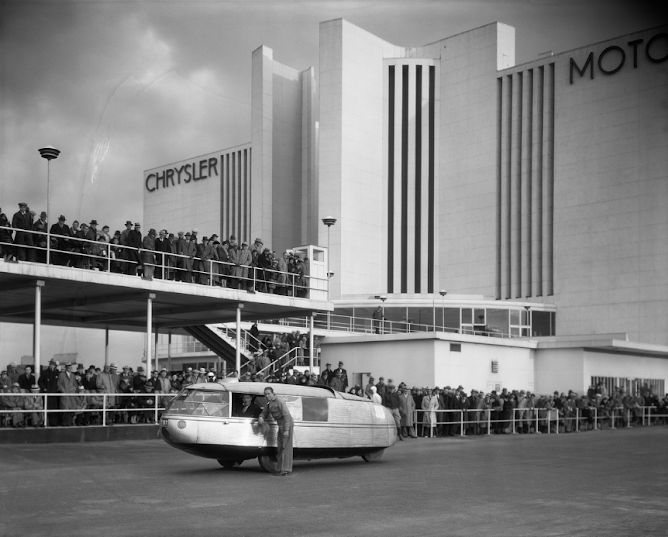Richard Buckminster (Bucky) Fuller conducted a wind tunnel test on three-wheeled teardrop shapes with a V-shaped groove running under the vehicle. A rudder was also added to the vehicles and Fuller intended that this would unfold from the upper side of the tail and provide stability.
 |
| Richard Buckminster (Bucky) Fuller |

 |
| Gulf Dymaxion Car Number One, designed by Buckminster Fuller, outside the Chrysler Motors Building at the Century of Progress International Exposition in Chicago, Illinois, 1933. |
A conventional 1933 car would have required, Fuller estimated, at least a 300 hp engine. Fuller also claimed that fuel consumption of the Dymaxion car Number One was 30% less than a conventional car at 30mph and 50% less at 50mph. The Dymaxion weighed in around 1600 lbs. It was extraordinary maneuverability and could U-turn within its own length.
 The two front wheels of the Dymaxion Car One were driven by a Ford V-8 engine. The single wheel at the rear was steerable.
The two front wheels of the Dymaxion Car One were driven by a Ford V-8 engine. The single wheel at the rear was steerable.
 On Dymaxion Cars Number Two and Three an angled periscope was provided to help compensate for the lack of a rear window. Initially, the car created vast attention where ever it went. However, a British auto enthusiast flew to Chicago to examine the Dymaxion car, and when he was injured and his driver killed after the Dymaxion collided with another car the headlines in the press referred to the vehicle as a “freak car” and undermined its 3-wheeled design. Although an investigation exonerated the Dymaxion car the car received a bad reputation and the British group canceled their order for Dymaxion Car Two.
On Dymaxion Cars Number Two and Three an angled periscope was provided to help compensate for the lack of a rear window. Initially, the car created vast attention where ever it went. However, a British auto enthusiast flew to Chicago to examine the Dymaxion car, and when he was injured and his driver killed after the Dymaxion collided with another car the headlines in the press referred to the vehicle as a “freak car” and undermined its 3-wheeled design. Although an investigation exonerated the Dymaxion car the car received a bad reputation and the British group canceled their order for Dymaxion Car Two.
 The Dymaxion Car Three was featured in the finale of Edward Hungerford’s “Wings of a Century” exhibit at the Century of Progress Exposition. The "Wings Of A Century" production took place daily on an open-air stage opposite the Travel & Transport Building which housed the displays.
The Dymaxion Car Three was featured in the finale of Edward Hungerford’s “Wings of a Century” exhibit at the Century of Progress Exposition. The "Wings Of A Century" production took place daily on an open-air stage opposite the Travel & Transport Building which housed the displays.
 The design of the Dymaxion cars was one of the biggest breakthroughs in automobile design since the car had originated some fifty years earlier. Only one car (Car Two) now remains and is kept at the National Auto Museum, Reno NV.
The design of the Dymaxion cars was one of the biggest breakthroughs in automobile design since the car had originated some fifty years earlier. Only one car (Car Two) now remains and is kept at the National Auto Museum, Reno NV.
Compiled by Dr. Neil Gale, Ph.D.




 |
| 2010 Working Replica of the Dymaxion. |

No comments:
Post a Comment
The Digital Research Library of Illinois History Journal™ is RATED PG-13. Please comment accordingly. Advertisements, spammers and scammers will be removed.